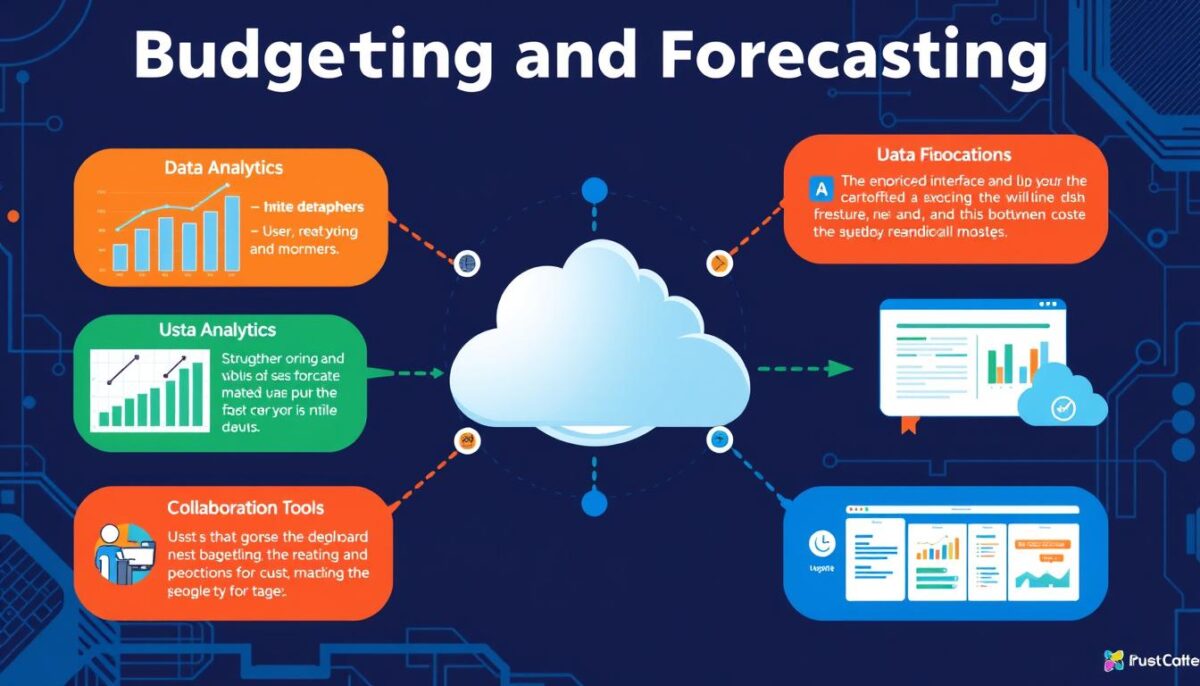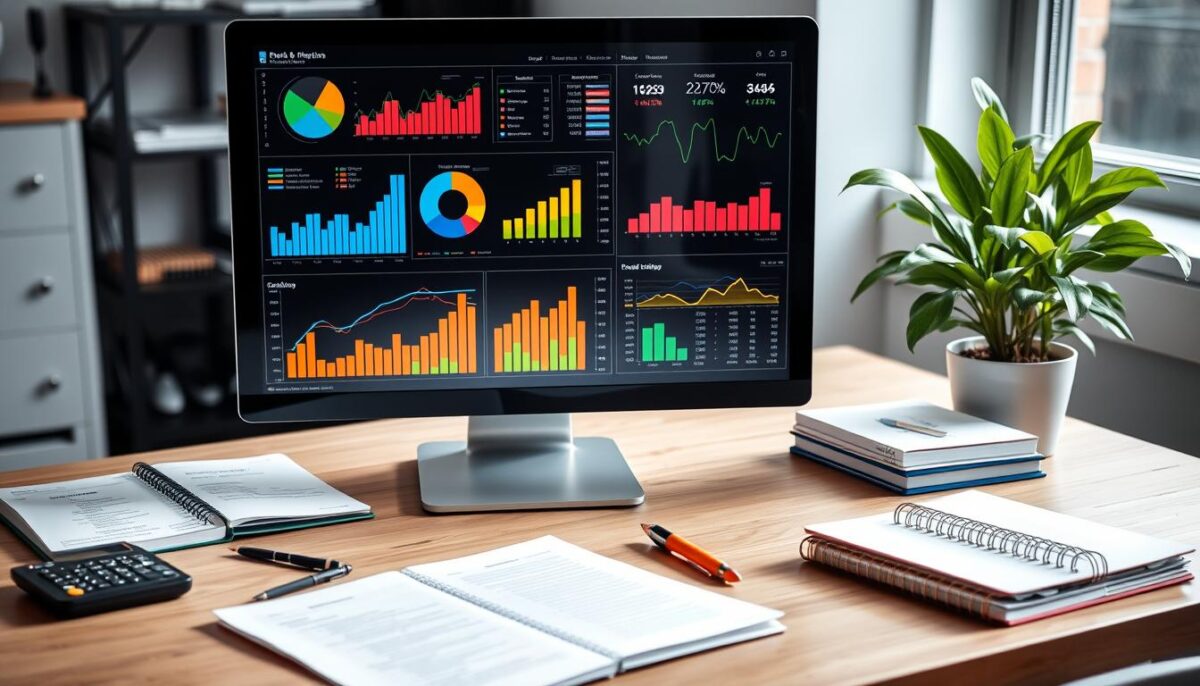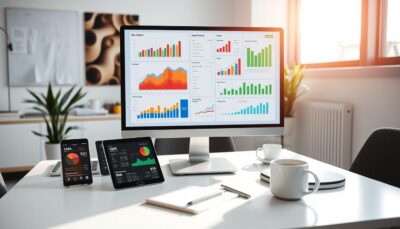In today’s fast-paced business world, having a strong financial plan is key. Budgeting and forecasting software are essential tools for any business. They help streamline finances, improve decision-making, and boost growth.
These platforms offer a wide range of features. They are designed to make financial planning, budgeting, and forecasting easier. This way, companies can make smart choices and stay competitive.
Key Takeaways
- Budgeting and forecasting software solutions provide a centralized platform for financial planning and analysis.
- These tools can improve financial accuracy, enhance cross-functional collaboration, and save time in the budgeting process.
- Key features to look for include user-friendly interfaces, robust integration capabilities, and advanced reporting and analytics tools.
- Popular options include Adaptive Insights, Planful, and Oracle Hyperion, each offering unique capabilities to meet diverse business needs.
- Choosing the right software solution requires assessing your company’s specific requirements and budget considerations.
Introduction to Budgeting and Forecasting Software
In today’s fast-paced business world, managing finances is more than just using a spreadsheet. Budgeting and forecasting software are key tools that change how companies plan and track their money. They offer a detailed way to track expenses, predict cash flow, and make smart decisions.
What is Budgeting and Forecasting Software?
Budgeting and forecasting software is a set of digital tools for better financial planning. They combine different financial data to help users make detailed budgets and predict cash flow. These tools simplify complex tasks, giving businesses a single place to manage their finances.
Importance in Business Management
Budgeting and forecasting software are vital for good business management. They help improve financial accuracy and strategic planning. With tools for tracking expenses and predicting cash flow, companies can better handle market changes. This leads to growth and profit.
“Budgeting and forecasting software has been instrumental in our ability to make data-driven decisions and stay ahead of the curve. The insights we’ve gained have been invaluable in navigating the complexities of our industry.”
Key Features to Look for in Software
Choosing the right budgeting and forecasting software is crucial for your business. Look for features that boost your revenue forecasting and business intelligence. These features can greatly improve your financial planning and analysis.
User-Friendly Interface
A good software should have an easy-to-use interface. It should be simple to navigate and organize. This makes it easy for your team to find and use the tools they need.
Integration Capabilities
The software should work well with your current systems. This includes accounting software, CRM platforms, and data warehouses. Good integration means less manual work and smoother data flow.
Reporting and Analytics Tools
Strong reporting and analytics are key. Look for software with many reporting options and advanced analytics. These tools help turn data into useful insights for better decision-making.
Focus on these features when choosing your software. They will help improve your financial planning and analysis. This leads to better revenue forecasting and business intelligence.

“Effective budgeting and forecasting software should serve as a powerful tool to drive strategic decision-making and achieve your financial goals.”
Popular Budgeting and Forecasting Software Options
There are many great options for budgeting and forecasting software. We’ll look at three top ones: Adaptive Insights, Planful, and Oracle Hyperion. Each offers special features to make financial planning easier.
Adaptive Insights
Adaptive Insights is a cloud-based tool known for its easy use and detailed reports. It lets users make custom budgets and track finances. It also works well with other business systems, fitting all sizes of organizations.
Planful
Planful, once Host Analytics, is a top choice for budgeting and forecasting. It’s cloud-based, so you can access your data anywhere. Its advanced analytics help make informed decisions. It’s great for complex financial modeling.
Oracle Hyperion
Oracle Hyperion is a strong EPM solution with great budgeting and forecasting. It fits well with Oracle products, making it a good choice for those already using Oracle. Its data analytics and reports offer deep insights into finances.
Each software has its own strengths and weaknesses. It’s key to match your needs with the right tool. The right software can improve financial accuracy, enhance teamwork, and save time.
| Feature | Adaptive Insights | Planful | Oracle Hyperion |
|---|---|---|---|
| Cloud-based Architecture | ✓ | ✓ | ✓ |
| Customizable Reporting | ✓ | ✓ | ✓ |
| Advanced Analytics | ✓ | ✓ | ✓ |
| Integrations with Other Systems | ✓ | ✓ | ✓ |
| Scenario Planning | ✓ | ✓ | ✓ |
Each platform has unique features for budgeting and forecasting. By understanding your needs, you can choose the best software for your financial planning.
Benefits of Using Budgeting Software
Using enterprise resource planning (ERP) and financial planning tools can bring many benefits to businesses. It improves financial accuracy, boosts collaboration, and saves time. This investment can help businesses grow and become more profitable.
Improved Financial Accuracy
Budgeting software makes financial planning easier and less prone to errors. It offers a single place for managing data. This leads to better forecasting and reporting, helping make smarter decisions.
Enhanced Collaboration
Today’s budgeting software helps teams work together better. It breaks down barriers between departments, making everyone understand the company’s financial health. With easy access to data, teams can work together more effectively to meet goals.
Time-Saving Capabilities
ERP and financial planning tools save a lot of time and effort. They automate tasks like data integration and report generation. This lets finance teams focus on more important tasks, boosting productivity and efficiency.
| Benefit | Description |
|---|---|
| Improved Financial Accuracy | Budgeting software reduces the risk of human errors, providing a centralized platform for data management and more precise financial forecasting and reporting. |
| Enhanced Collaboration | Modern budgeting tools facilitate real-time collaboration among team members, breaking down departmental silos and aligning resources towards strategic objectives. |
| Time-Saving Capabilities | Automation features in enterprise resource planning (ERP) and financial planning tools streamline the budgeting and forecasting process, allowing finance professionals to focus on higher-value activities. |

By using ERP and financial planning tools, businesses can achieve many benefits. These include financial stability, better operations, and smarter decision-making. In today’s complex world, investing in good budgeting software is crucial for success.
Streamlining the Budgeting Process
Effective budgeting and forecasting software can change how businesses plan their finances. It helps set realistic goals and automates data collection. These tools make budgeting easier and give businesses an edge.
Setting Realistic Goals
Setting financial targets is key to a good budget. Budgeting software helps businesses see their finances clearly and set goals. This way, goals are based on real data, avoiding unrealistic expectations.
Automating Data Collection
Manual data entry is slow and often wrong. Budgeting software fixes this by linking with financial systems. This makes data collection faster and more accurate, helping businesses make better choices.
Using budgeting and forecasting software helps businesses plan better. They can set realistic goals and make decisions based on data. This approach helps them handle business challenges with confidence and precision.
Forecasting Techniques Supported by Software
Modern business intelligence software brings powerful forecasting tools to budgeting and financial planning. These tools help make revenue forecasting and financial projections more accurate. They offer advanced analytical capabilities, moving beyond simple budgeting methods.
With these tools, businesses can make decisions based on solid data insights. This is a big step forward in financial planning.
Trend Analysis
Trend analysis is a key feature in budgeting software. It looks at past financial data to spot patterns and trends. This helps predict future performance.
Businesses can then plan better and make decisions based on data. This is crucial for anticipating changes in revenue and expenses.
What-If Scenarios
Budgeting software also lets businesses create and analyze “what-if” scenarios. They can change variables like sales projections or cost structures. This helps see how different outcomes might affect their finances.
Scenario planning prepares businesses for various situations. It also lets them explore different strategies for a better financial future.
Regression Analysis
Regression analysis tools are often part of budgeting software. They find relationships between financial variables to forecast future performance. This advanced method uncovers hidden connections.
It helps businesses make more precise revenue forecasts and financial projections. This boosts their business intelligence and strategic decision-making.
By using these advanced forecasting techniques, businesses can stay ahead in the market. They can make better financial decisions and drive growth and profitability over time.

Choosing the Right Software for Your Business
Finding the right budgeting and forecasting software is key to better financial management. It’s important to match your company’s needs and budget to the software. This ensures it fits well and works efficiently.
Assessing Your Company’s Needs
Start by looking at what your business needs. Think about your company’s size, financial complexity, and what features are most important. Look for data analytics platforms, easy integration, and user-friendly interfaces. These help your team work better and make smarter decisions.
Budget Considerations
It’s also crucial to consider your budget. Look for cloud-based solutions with flexible pricing. This lets you start small and grow as needed. Remember to include costs for setup, upkeep, and the software’s long-term benefits.
By carefully looking at your needs and budget, you can choose the best software for your business.
Implementation and Training
Using enterprise resource planning (ERP) and financial planning tools can change a business for the better. But, making the switch smoothly is key. By following the right steps and keeping up with training, companies can get the most out of their budgeting and forecasting software.
Strategies for Smooth Implementation
To make the transition easy, consider these strategies:
- Know what you need and want from your software.
- Get everyone involved to make sure everyone is on board.
- Make a detailed plan with deadlines and who does what.
- Teach all users how to use the software well.
- Have one person in charge to handle any problems.
Importance of Ongoing Training
Keeping up with training is key to getting the most from your budgeting and forecasting software. By investing in ongoing education, your team can:
- Use all the software has to offer.
- Keep up with software updates.
- Get better at financial planning and analysis.
- Make sure data is accurate and reports are reliable.
- Build a culture of smart financial decisions.
The journey to financial success doesn’t end with setup and training. It’s an ongoing path. By working together and being strategic, your company can fully benefit from enterprise resource planning (ERP) and financial planning tools.
| Key Strategies for Smooth Implementation | Benefits of Ongoing Training |
|---|---|
|
|
Measuring Success with Budgeting Software
Organizations use data analytics platforms and business intelligence software to better their budgeting and forecasting. It’s key to measure how well these tools work. By tracking important performance indicators and checking the software’s performance often, businesses can make sure their tools help achieve their goals.
Key Performance Indicators
When checking if budgeting and forecasting software is working, look at these KPIs:
- How accurate are financial predictions and forecasts?
- How much time does it save in budgeting and forecasting?
- Does it help teams work better together?
- Is financial data more visible and clear?
- Is there less manual data entry and fewer mistakes?
Regular Reviews and Adjustments
It’s important to regularly check how your budgeting and forecasting software is doing. Do this every few months to see if it still fits your business needs. You might need to:
- Get feedback from users to know what they like and what they don’t.
- Look at KPIs to find trends and ways to get better.
- See if there are new features or ways to make the software better.
- Change budgets, forecasts, and workflows based on what you learn.
By always watching and improving your budgeting and forecasting software, it will stay a valuable tool. It will help with business intelligence and making strategic decisions.
| KPI | Baseline | Current | Target |
|---|---|---|---|
| Accuracy of financial projections | 85% | 92% | 95% |
| Time saved in budgeting process | 20 hours/month | 30 hours/month | 40 hours/month |
| Improved collaboration among finance teams | 3.8 (out of 5) | 4.2 (out of 5) | 4.5 (out of 5) |
Common Challenges and Solutions
When companies start using budgeting and forecasting software, they often hit two big hurdles. These are data integration problems and getting users to accept the new tools. But, with smart strategies, businesses can beat these challenges and enjoy the benefits of these tools.
Data Integration Issues
One big problem is linking the new software with old financial data. It’s hard because of old systems and scattered data. To solve this, companies should work on strong data integration. They should use APIs and cloud solutions that can connect to many data sources.
User Adoption Resistance
Another big challenge is getting people to use the new software. Employees might not want to change their ways or feel scared of new tech. To fix this, companies should focus on making the change smooth. They should offer good training and create a team spirit that encourages learning.
| Challenge | Solution |
|---|---|
| Data Integration Issues |
|
| User Adoption Resistance |
|
By tackling these common problems and finding good solutions, companies can make budgeting and forecasting software work for them. This way, they can get the most out of expense tracking apps and cloud solutions.
Future Trends in Budgeting and Forecasting Software
The future of budgeting and forecasting software looks bright. We can expect big changes with the use of artificial intelligence (AI) and machine learning. Also, there will be a big push for analyzing data in real-time.
AI and Machine Learning Innovations
AI and machine learning will change how we plan finances. They will make forecasting more accurate and data analysis easier. This means businesses can predict market changes and adjust their plans better.
Increased Focus on Real-Time Data
There’s a big move towards using data right when it happens. This will make financial decisions faster and smarter. Companies will be able to react quickly to market changes, improving their financial planning.
FAQ
What is budgeting and forecasting software?
Budgeting and forecasting software are tools for financial planning. They help organizations manage their finances better. These tools provide a place to track money, predict future earnings, and make smart decisions.
Why is budgeting and forecasting software important for businesses?
It’s key for good business management. It makes financial planning more accurate and saves time. It helps set financial goals, track spending, and predict income to guide planning.
What are the key features to look for in budgeting and forecasting software?
Look for an easy-to-use interface and good integration with other systems. Also, check if it has strong reporting and analytics tools. This ensures the software is easy to use and provides valuable insights.
What are some popular budgeting and forecasting software options?
Top choices include Adaptive Insights, Planful, and Oracle Hyperion. Each offers different features to meet various business needs.
What are the benefits of using budgeting software?
It improves financial accuracy and teamwork. It also saves time and works well with other systems. This makes financial planning more comprehensive.
How can budgeting software streamline the budgeting process?
It helps set financial goals and automates data collection. It offers a place to track spending and predict cash flow. This makes budgeting more efficient and accurate.
What forecasting techniques are supported by budgeting software?
It supports advanced techniques like trend analysis and scenario planning. These help analyze past data and predict future income. This supports better decision-making.
How can I choose the right budgeting software for my business?
Consider your business needs and budget. Look at scalability and long-term value. This helps find the right fit for your financial planning.
How can I ensure a smooth implementation of budgeting software?
Plan well, train your team, and communicate clearly. Offer ongoing support and review the software’s performance. This ensures it meets your needs.
How can I measure the success of my budgeting software implementation?
Track KPIs like accuracy and time savings. Regularly review and adjust the software. This keeps it aligned with your goals.
What are some common challenges in implementing budgeting software, and how can they be addressed?
Challenges include data issues and user resistance. Use clear data protocols, provide training, and encourage teamwork. This helps overcome these hurdles.
What are the future trends in budgeting and forecasting software?
Future trends include AI and real-time data analysis. These advancements will improve financial predictions and decision-making. They will help businesses stay agile and confident.







